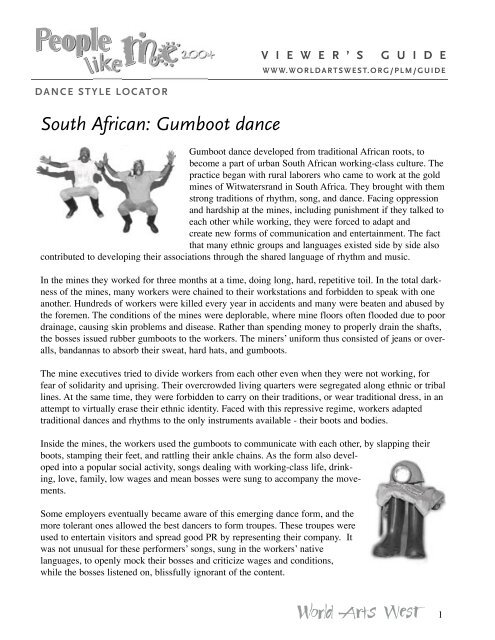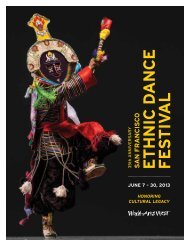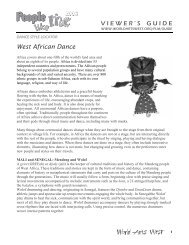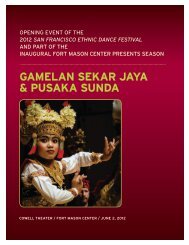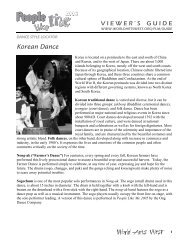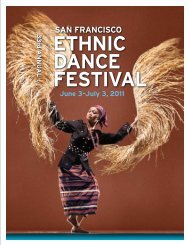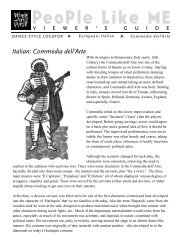South African: Gumboot dance - World Arts West
South African: Gumboot dance - World Arts West
South African: Gumboot dance - World Arts West
You also want an ePaper? Increase the reach of your titles
YUMPU automatically turns print PDFs into web optimized ePapers that Google loves.
V I E W E R ’ S G U I D E<br />
W W W. W O R L D A R T S W E S T. O R G / P L M / G U I D E<br />
DANCE STYLE LOCATOR<br />
<strong>South</strong> <strong>African</strong>: <strong>Gumboot</strong> <strong>dance</strong><br />
<strong>Gumboot</strong> <strong>dance</strong> developed from traditional <strong>African</strong> roots, to<br />
become a part of urban <strong>South</strong> <strong>African</strong> working-class culture. The<br />
practice began with rural laborers who came to work at the gold<br />
mines of Witwatersrand in <strong>South</strong> Africa. They brought with them<br />
strong traditions of rhythm, song, and <strong>dance</strong>. Facing oppression<br />
and hardship at the mines, including punishment if they talked to<br />
each other while working, they were forced to adapt and<br />
create new forms of communication and entertainment. The fact<br />
that many ethnic groups and languages existed side by side also<br />
contributed to developing their associations through the shared language of rhythm and music.<br />
In the mines they worked for three months at a time, doing long, hard, repetitive toil. In the total darkness<br />
of the mines, many workers were chained to their workstations and forbidden to speak with one<br />
another. Hundreds of workers were killed every year in accidents and many were beaten and abused by<br />
the foremen. The conditions of the mines were deplorable, where mine floors often flooded due to poor<br />
drainage, causing skin problems and disease. Rather than spending money to properly drain the shafts,<br />
the bosses issued rubber gumboots to the workers. The minersʼ uniform thus consisted of jeans or overalls,<br />
bandannas to absorb their sweat, hard hats, and gumboots.<br />
The mine executives tried to divide workers from each other even when they were not working, for<br />
fear of solidarity and uprising. Their overcrowded living quarters were segregated along ethnic or tribal<br />
lines. At the same time, they were forbidden to carry on their traditions, or wear traditional dress, in an<br />
attempt to virtually erase their ethnic identity. Faced with this repressive regime, workers adapted<br />
traditional <strong>dance</strong>s and rhythms to the only instruments available - their boots and bodies.<br />
Inside the mines, the workers used the gumboots to communicate with each other, by slapping their<br />
boots, stamping their feet, and rattling their ankle chains. As the form also developed<br />
into a popular social activity, songs dealing with working-class life, drinking,<br />
love, family, low wages and mean bosses were sung to accompany the movements.<br />
Some employers eventually became aware of this emerging <strong>dance</strong> form, and the<br />
more tolerant ones allowed the best <strong>dance</strong>rs to form troupes. These troupes were<br />
used to entertain visitors and spread good PR by representing their company. It<br />
was not unusual for these performersʼ songs, sung in the workersʼ native<br />
languages, to openly mock their bosses and criticize wages and conditions,<br />
while the bosses listened on, blissfully ignorant of the content.<br />
1
V I E W E R ’ S G U I D E<br />
W W W. W O R L D A R T S W E S T. O R G / P L M / G U I D E<br />
DANCE STYLE LOCATOR<br />
(<strong>Gumboot</strong> <strong>dance</strong>, continued)<br />
<strong>Gumboot</strong> <strong>dance</strong> is now a popular art form performed worldwide to entertain and pass on elements of<br />
<strong>South</strong> <strong>African</strong> history to new generations and other cultures. Like many folkloric art forms, it is adapted<br />
to the modern contexts in which it is performed.<br />
The following is a translation of a song that is sung with <strong>Gumboot</strong> <strong>dance</strong>. The rich harmonies are characteristic<br />
of much <strong>South</strong> <strong>African</strong> music:<br />
MAHLALELA<br />
HEE MAHLALELA<br />
HAMBUʼ UYO SEBENZA<br />
HEE MAHLALELA<br />
HAMBHʼ UYO SEBENZA<br />
HEE HEE<br />
HE MAHLALELEA<br />
HAMBHʼ UYO SEBENZA<br />
HE MAHLALELA<br />
HAMBHʼ UYO SEBENZA<br />
ENGLISH TRANSLATION:<br />
LOAFER GO AND WORK<br />
MAHLALELA ... LOAFER<br />
HAMBHA ... GO<br />
UYO ... YES<br />
SEBENZA ... WORK<br />
2
V I E W E R ’ S G U I D E<br />
W W W. W O R L D A R T S W E S T. O R G / P L M / G U I D E<br />
DANCE STYLE LOCATOR<br />
Bolivian/Peruvian Andes: Andean <strong>dance</strong><br />
The Aymara and the Quechua cultures are among the indigenous civilizations<br />
that still dwell in the Andes Mountains of <strong>South</strong> America,<br />
which cover parts of Bolivia, Peru, Ecuador and Chile. These cultures<br />
have continued to carry on traditions of <strong>dance</strong> and music that<br />
date back to earlier than 15,000 BC.<br />
The Aymara culture has a wealthy repertoire of folk <strong>dance</strong> and music<br />
known as Native (pre-Colombian) and Mestizo <strong>dance</strong>, which originated<br />
after the Spanish conquest and incorporated European influences.<br />
In urban centers, Mestizo <strong>dance</strong>s have found much popularity, especially<br />
during local festivities and celebrations of patron saints, while<br />
Native <strong>dance</strong> has only found minimal acceptance. However, Native<br />
<strong>dance</strong> is still performed in rural areas during religious or secular community celebrations, examples of<br />
this <strong>dance</strong> being: Sikuris, Pinkillus, Chaqallus, Lawa kʼumus, Chuqilas, Kʼusillos.<br />
The events during which music and <strong>dance</strong> are traditionally performed in this region are considered<br />
expressions of communitás: an expression of community structure and solidarity through ceremonial<br />
events, which interpret and reaffirm common values and identity. Whether the event is religious or secular,<br />
private or communal, music and <strong>dance</strong> are important mechanisms of communication and underline<br />
the communitás.<br />
Andean music is known as that music performed by the four basic instruments: siqu (siku), -also called<br />
panpipes or zampoñas – charango (stringed instrument), bombo (drum), and quena (flute). The siqu is<br />
of Aymara origin, while the charango was created after the Spanish conquest, as string instruments were<br />
originally unknown in the Andes. In ancient times the charango was made with the carapace of the<br />
armadillo, which historians believe first originated in Aymara territory (Potosi) in the 17th century.<br />
Until the 1960s these instruments were played only by indigenous<br />
people in remote and rural areas. From the second half of the 1960s<br />
onwards, a sector of young people in Chile started up a political and<br />
cultural protest movement. This social current adopted as its symbol<br />
the musical trend known as nueva cancion or cancion protesta, which<br />
is performed with the four indigenous instruments. Victor Jara, Inti<br />
Illimani, Kollawara, and Quilapayun were the first exponents of nueva<br />
cancion. Later this music spread to the rest of the Andean countries<br />
and became popular among students there, especially in Bolivia and<br />
Peru, countries that were, at the time, under military regimes. At the beginning of the 1980s however,<br />
3
V I E W E R ’ S G U I D E<br />
W W W. W O R L D A R T S W E S T. O R G / P L M / G U I D E<br />
DANCE STYLE LOCATOR<br />
(Andean <strong>dance</strong>, continued)<br />
the political message of the nueva cancion was abandoned, and this music then became commercially<br />
acceptable, as it transformed into what we now know as Andean Music.<br />
A recent development in the Andes, as in many areas of the world, is that of “folkloric” music and <strong>dance</strong><br />
groups that perform on stage rather than as part of a religious or secular communal event. Beginning<br />
in 1978, around the time that tourism to the area started to increase, local musicians and <strong>dance</strong>rs began<br />
to perform in tourist restaurants in urban centers, and folkloristic groups in touristic taverns. Latin<br />
American folk music, played live by groups of young middle class Mestizos alternated with recorded<br />
<strong>West</strong>ern disco music.<br />
Suri Siquris is a <strong>dance</strong> that dates back to 800 BC. The name comes from the great headdress made of<br />
feathers from the suri or ñandu (American ostrich) and the <strong>dance</strong> is done in relation to the harvest. The<br />
musicians who play the siqus and <strong>dance</strong> are known as Siquris. The siqus has 17 canes, and comes in<br />
four sizes. They are played in sets of two, in interlocking melody and rhythm. The men dress in beautiful<br />
Alpaca ponchos with color tassels called wichiwichi, and the women dress in beautiful party skirts.<br />
Huayno, also spelled Huaiño or Wayno, is widely recognized as the most representative <strong>dance</strong> of the<br />
Andes, with pre-Columbian (Quechua and Aymara) origins fused with <strong>West</strong>ern influences. While historians<br />
speculate that it may have come from an Inca funeral <strong>dance</strong>, today it is purely festive. A circle of<br />
dancing couples surrounds the musicians, whose instruments may be flutes, drums, harps, and guitars.<br />
Couples dancing the huayno perform sharp turns, hops, and tap-like zapateos to keep time.<br />
Huayno music is played on quena, charango, harp, and violin, however, there are dozens of regional<br />
variations, some of which involve marching bands, trumpets, saxophones and accordions. The musical<br />
structure stems from a pentatonic scale (scale of five notes) with a binary rhythm, (2/4 time). This<br />
structure has made this genre the basis of a series of hybrid rhythms, running from huayno to Andean<br />
rock.<br />
4
V I E W E R ’ S G U I D E<br />
W W W. W O R L D A R T S W E S T. O R G / P L M / G U I D E<br />
DANCE STYLE LOCATOR<br />
Hawaiian Hula<br />
Hula is a sacred tradition for the Hawaiian people, going<br />
back to ancient times, when chants and body movements<br />
were first used as forms of communication with the gods.<br />
Until fairly recently, the Hawaiian language was primarily<br />
oral rather than written, with history and tradition passed<br />
down through <strong>dance</strong> and chants from generation to generation.<br />
The survival of hula is an integral part of Hawaiiʼs past<br />
and future, having kept alive much of the cultureʼs history,<br />
including a chronology of important events, battles fought<br />
and genealogical histories of the people. Hula has also preserved<br />
details about traditions from old Hawaiʼi, such as that<br />
of making leis, flower gathering, and preparing vegetation<br />
for medicinal purposes. The practice of hula continues to<br />
honor certain gods, goddesses and other deities, as well as<br />
natural elements, historical figures, and other aspects of creation.<br />
During Hawaiiʼs missionary era in the early 1800ʼs, most<br />
forms of native Hawaiian expression, including hula, were<br />
suppressed, and it wasnʼt until 70+ years later that the art<br />
form was again performed publicly. King Kalākaua, the<br />
last reigning king, once said, “Hula is the heartbeat of the<br />
Hawaiian people.” Hula continues to carry the history and tradition, and the spirit and strength of the<br />
Hawaiian people through the generations.<br />
PELE<br />
Legend tells us that the goddess Pele used intense fire, heat and explosive energy to create pits of churning<br />
lava that awakened the islands of Hawaiʼi. Escaping from the jealous sea goddess who sought to<br />
extinguish her flames, Pele journeyed through the islands of Niʼihau, Kauaʼi, Oʼahu, Molokaʼi, Lanaʼi<br />
and then to Maui – but found scarce protection from the enemy waters. She finally came to the island<br />
of Hawaiʼi and found the place that fulfilled her desires: the pit of Halemaʼumaʼu along the expansive<br />
slopes of Kïlauea -- far from the sea.<br />
Peleʼs youngest and most beloved sister, Hiʼiakaikapoliopele was the first student of hula. Therefore,<br />
many chants and <strong>dance</strong>s were composed in honor of Pele, filled with her power and energy, and with<br />
imagery of the land surrounding her home. Pele remains an earth-creating force from her home on<br />
Hawaiʼi, where her majestic fountains of fire, rivers of molten magma and hissing jet-black fields of<br />
cooling lava still inspire the Hawaiian people today.<br />
5
V I E W E R ’ S G U I D E<br />
W W W. W O R L D A R T S W E S T. O R G / P L M / G U I D E<br />
DANCE STYLE LOCATOR<br />
(Hawaiian Hula, continued)<br />
Here are some of the musical “implements” and instruments used in hula.<br />
Ipu Heke or<br />
Ipu Heke `ole:<br />
Pu`ili:<br />
`Ili`ili:<br />
Ka`eke`eke:<br />
`Ohe Hano Ihu:<br />
Pahu:<br />
A double gourd drum. Basic beats help<br />
keep the time and rhythm for the <strong>dance</strong>rs<br />
to follow.<br />
Split bamboo stick used to enhance and<br />
express the meaning of the song. The<br />
sounds are meant to be reflective of<br />
nature.<br />
River worn stones castanets. Smooth<br />
stones (2 in each hand) used to keep time<br />
and rhythm of the <strong>dance</strong> and express the<br />
natural surroundings the particular <strong>dance</strong><br />
speaks of.<br />
Bamboo stamping pipes. 2 different sized<br />
(1 tall, 1 shorter) bamboo pipes stamped<br />
on the ground gives 2 different<br />
harmonizing pitches used to keep timing<br />
of the <strong>dance</strong>.<br />
Bamboo nose flute. This flute with only 3 holes for the fingers and 1 hole for air<br />
is used with the air from the nose. It is said that the air from the ihu (nose) is most<br />
pure.<br />
Shark skin drum. A hollowed coconut log attached with sennit (a rope from the<br />
coconut fruit) and stretched shark skin top. This drum was once only used for<br />
sacred religious ceremonies. Today, although still used for religious ceremonies,<br />
the pahu is also used to accompany <strong>dance</strong>s outside of ceremony.<br />
6
V I E W E R ’ S G U I D E<br />
W W W. W O R L D A R T S W E S T. O R G / P L M / G U I D E<br />
DANCE STYLE LOCATOR<br />
North Indian: Kathak<br />
Kathak is among the six major classical <strong>dance</strong>s of India,<br />
and one of the most dynamic theater arts in the world.<br />
The word kathak is derived from katha, meaning the “art<br />
of storytelling.” It is also<br />
synonymous with the community of artists known as<br />
Kathakas, whose hereditary profession was to<br />
narrate history while entertaining. With <strong>dance</strong>, music<br />
and mime these storytellers of ancient India would bring<br />
to life the great scriptures and epics of ancient times,<br />
especially the Mahabharata, Ramayana, and Puranas of<br />
Sanskrit literature.<br />
From its early form as a devotional expression<br />
dedicated to the Hindu gods, kathak gradually moved<br />
out of the temples and into the courts of the rulers: the<br />
Hindu Maharajas and the Muslim Mughals. The Muslim<br />
conquest of India led to the Mughal Empires of the 15 th<br />
through 19 th centuries, creating a distinctive Indian-<br />
Islamic civilization, manifested largely through the arts.<br />
It was here that the Mughal leaders hired Kathakas to<br />
entertain them in their lavish courts. Due to the Islamic<br />
ideology, which forbade the representation of God in<br />
human forms, the <strong>dance</strong>rs needed to modify and disguise religious movements. It is in this period that<br />
the <strong>dance</strong> form was developed to include the intricate and mathematically complex footwork.<br />
Though the Mughal Empires underwent decline during the British invasion of the mid-18 th century,<br />
about 100 years later kathak enjoyed a renaissance and gained prominence among the Muslim Nawabs<br />
and zamindars (feudal overlords) not only as a form of entertainment, but also as a burgeoning classical<br />
art form. The rise in status and popularity in the early 1900ʼs is largely due to interest and attention<br />
from renowned <strong>dance</strong>rs of various <strong>dance</strong> forms, from inside and outside of India. Kathak continues to<br />
develop and incorporate fresh innovations, and is presented around the world as an important North<br />
Indian classical art form.<br />
Footwork and “Bols”<br />
Tatkar is the basic footwork of kathak. While the origin of this footwork still remains uncertain, it is<br />
considered to have been derived from the natawari bols (syllables) ta, thei, and tat. Natawara is<br />
7
V I E W E R ’ S G U I D E<br />
W W W. W O R L D A R T S W E S T. O R G / P L M / G U I D E<br />
DANCE STYLE LOCATOR<br />
(Kathak, continued)<br />
another name for the deity Lord Krishna, meaning “Lord of the <strong>dance</strong>” or “best among <strong>dance</strong>rs.” It is<br />
believed that when Natawara subdued the monster-serpent Kaliya and <strong>dance</strong>d on its hood, the sound ta,<br />
thei and tat were produced.<br />
In kathak, the idea of worship through <strong>dance</strong> involves the spiritual relationship of the <strong>dance</strong>r in contact<br />
with the earth, in order to reach God.<br />
Ta, body (from Tanu)<br />
Thei, Earth (from Sthela)<br />
Ei, Lord (from Eishwara)<br />
The body that <strong>dance</strong>s on the earth for the Lord.<br />
Tatkar has developed into a very sophisticated<br />
system of footwork and rhythmic patterns. Modern<br />
kathak leans heavily on the elements of technique,<br />
and tatkar is the fundamental footwork from which<br />
all other foot sounds and compositions are created.<br />
By nature it is a very grounding force, and when<br />
executed correctly resonates a melodious sound.<br />
Tatkar is also a study into the power of energy.<br />
The soles of the feet generate a flow of energy which streams through all the cells in the muscles and<br />
bones of the body as the body moves in tune with the energy. The energy flows up to the crown of the<br />
mind, dissolving thought as it unites with the energy, and a harmony of body and mind is realized. It is<br />
at this level that <strong>dance</strong> becomes a yogic practice.<br />
8
V I E W E R ’ S G U I D E<br />
W W W. W O R L D A R T S W E S T. O R G / P L M / G U I D E<br />
DANCE STYLE LOCATOR<br />
North American: Hambone<br />
Hambone was created by enslaved <strong>African</strong>s in North America.<br />
Forbidden to use their drums, slaves found ways to make rhythms<br />
with tambourines, bones, and body music such as hand clapping,<br />
body and thigh slapping, also called “Pattinʼ Juba.”<br />
The name “hambone” refers to the daily activities of the early<br />
<strong>African</strong> American slave communities. In the days of slavery, families<br />
had to stretch the little food they were given, relying on their<br />
resourcefulness and creativity to survive under adverse conditions.<br />
The hambone (the bone of ham) was used to make a big pot of soup,<br />
which, with lots of water, and little scraps of vegetables and spices,<br />
was stretched to feed many families. That same hambone would be<br />
passed around and used repeatedly in different pots of soups, making<br />
something from nothing as a way of survival.<br />
The word “hambone” was then adopted as the name of the system of<br />
improvised rhythmic body music, which arose because slaves were<br />
forbidden to have or use drums. Using the same resourcefulness to<br />
perpetuate their traditions, the <strong>dance</strong> and music style of “hambone”<br />
was created, allowing cultural, sacred, and historic rhythms to survive<br />
and evolve. The use of the word Hambone, and the practice itself, is<br />
therefore a metaphor, honoring the cultural memory of the determination<br />
and creativity of <strong>African</strong> Americans in the United States throughout their history.<br />
Hambone rhyme/song<br />
Hambone Hambone where you been<br />
Around the world and back again!<br />
Thank you to Derique for his contribution to the content of this page.<br />
9
V I E W E R ’ S G U I D E<br />
W W W. W O R L D A R T S W E S T. O R G / P L M / G U I D E<br />
DANCE STYLE LOCATOR<br />
Spanish: Flamenco<br />
Flamenco is a <strong>dance</strong> form that arose in Spain, influenced by<br />
various populations passing through or living in the southern<br />
region of Andalusia. Beginning in the third century BC,<br />
Gypsies, Sephardic Jews, Christians, and Moors all contributed<br />
to Andalusian culture. The Moorish civilization was<br />
founded by Arabs and Berbers of North Africa, in the 8 th<br />
century. Like the Indian Mughals, the Moors cultivated and<br />
transformed the arts, by bringing them into their lavish courts<br />
as entertainment. As a result, Andalusia flourished and came<br />
to be regarded as a major cultural center from the 9 th to the<br />
15 th century.<br />
The Gypsies migrated from India to Spain in various waves,<br />
being influenced by the customs of peoples whose land they<br />
passed through, and incorporating elements of these customs<br />
into their own already unique customs, language and way of<br />
life. A nomadic people, the Gypsies were most often met by<br />
extreme persecution and condemnation wherever they went,<br />
and were often forced to survive under the most adverse conditions.<br />
Beginning in the 15 th century, Christian monarchs in the<br />
north of Spain demanded adherence to Christianity, and during the Spanish inquisition, Muslims, Jews,<br />
and Gypsies were forced to convert or leave Spain. Many people were tortured, persecuted and even<br />
killed if they refused to conform to the accepted standard of Spanish society. Poverty and persecution<br />
were widespread and affected Gypsies and non-Gypsies alike, and the once vigorous separation that<br />
existed between them faded away as a result of their shared struggles.<br />
Despite being persecuted by the Spanish Monarchy, the Gypsies continued to defend and assert cultural<br />
identity and ethnic pride, and maintain their own customs. The interplay between the Andalusian folk<br />
forms and Gypsy traditions forged the beginnings of flamenco <strong>dance</strong> and music. The first contexts of<br />
flamenco performance appeared to have been private, deeply emotional events that were kept hidden in<br />
close Gypsy familial gatherings. Early urban flamenco events took place in secluded rooms in bars, or in<br />
the patios of Gypsy dwellings. The suppressed passions and long-felt emotions of the Andalusian Gypsies<br />
were vocalized through flamenco in the cante (song), the primary element of flamenco.<br />
10
V I E W E R ’ S G U I D E<br />
W W W. W O R L D A R T S W E S T. O R G / P L M / G U I D E<br />
DANCE STYLE LOCATOR<br />
(Flamenco, continued)<br />
In the 19 th century, flamenco shifted from an intimate, ritualistic art form to a public entertainment form,<br />
developing the virtuosic footwork and an expansion of styles within the form. Performed by non-Gypsy<br />
and Gypsies alike, flamenco began to achieve legitimacy and public acclaim. The 20 th century technological<br />
growth and mass media further bolstered flamencoʼs popularity, as it came to be recognized nationally<br />
and internationally and moved into theatrical settings.<br />
Although the Gypsies were not honored for their contribution to the art form until many years later, they<br />
have always been considered among the best interpreters of the flamenco arts. In recent years flamenco<br />
has continued to develop, incorporating sophisticated musical stylistic elements from other mediums, however<br />
it still maintains a core of traditional styles and techniques.<br />
Canto (song) is the core of flamenco, and like baile (<strong>dance</strong>), it has three forms: grande or hondo (meaning<br />
grand or deep), intense, profound songs, tragic in tone, and imbued with duende, the transformation of the<br />
musician by the depth of the emotion; intermedio (intermediate), moderately serious; and pequeño (small),<br />
light songs of exuberance, love, and nature. Among these forms, several individual genres exist, including<br />
the light bulerías, the more serious soleares and its lighter descendant, the alegrías, among others.<br />
Both text and melody of these songs, like the flamenco <strong>dance</strong>, are improvised within traditional structures<br />
such as characteristic rhythms and chords. Zapateado, intricate toe- and heel-clicking steps, characterizes<br />
the menʼs <strong>dance</strong>; the traditional womenʼs <strong>dance</strong> is based more on grace of body and hand movements.<br />
The baile grande, especially, is believed to retain elements of the <strong>dance</strong> of North India, where the Gypsies<br />
originated. Castanets come from the influence of Andalusian <strong>dance</strong>. Jaleo, rhythmic finger snapping, hand<br />
clapping, and shouting often accompanies the song and <strong>dance</strong>. In the 19th century, guitar accompaniment<br />
became common for many genres, and guitar solos also developed as a part of the song/<strong>dance</strong> cycle.<br />
11
V I E W E R ’ S G U I D E<br />
W W W. W O R L D A R T S W E S T. O R G / P L M / G U I D E<br />
DANCE STYLE LOCATOR<br />
Related Topics: Body Music<br />
Body music is music/<strong>dance</strong> created by clapping, slapping,<br />
snapping, stepping and vocalizing. Body music<br />
was most likely the first music/<strong>dance</strong>. Before people<br />
were hollowing logs and slapping rocks to make<br />
musical instruments, they were probably stomping,<br />
clapping and making sounds to express their musical<br />
and <strong>dance</strong> ideas.<br />
Body music has existed for centuries, and many<br />
forms of it still exist today. This includes hambone<br />
and stepping in the U.S., to saman in Indonesia, palmas<br />
in Spain, and Ethiopian armpit music.<br />
Body music is accessible to all. To experiment with<br />
body music, itʼs easy to manifest familiar rhythms<br />
such as the 1-2-3 of a waltz, or the –2-4 of a reggae<br />
beat, by playing different parts of the rhythm on different parts of our bodies – for example, slapping<br />
knees, stomping feet, and clapping hands. Playing with the rhythm of words or nonsense syllables can<br />
also be body music. Accomplished musicians such as Keith Terry have developed body music into a contemporary<br />
art form with links to some traditional forms.<br />
The style of body music that Keith Terry has pioneered since the mid-1970ʼs is not a culture-specific<br />
style like those aforementioned, but a mixture of many influences: drumming, world music, tap <strong>dance</strong>,<br />
and circus arts. Through the years, Keith has gained knowledge of many diverse rhythm systems from<br />
around the world. As a drummer whose specialty is trap set, his body music initially came directly from<br />
displacing what he was playing on the drums, onto his body. On top of finding a portable way of playing<br />
rhythmic music, Terry also found mobility, which allows him to move in space, making it a movement<br />
art as well as a musical form.<br />
At the time of his initial experimentation, Keith was playing drums for some of the older generation of<br />
tap <strong>dance</strong>rs, most of whom have since passed on. Two masters in particular, Charles “Honi” Coles and<br />
Charles “Cookie” Cook, encouraged and advised Keith to pursue his unique style of body music. Keith<br />
is still following their advice, and the result is some very exciting body music, which combines elements<br />
from several world music sources with fresh innovations, forging a now increasingly popular style.<br />
12
V I E W E R ’ S G U I D E<br />
W W W. W O R L D A R T S W E S T. O R G / P L M / G U I D E<br />
DANCE STYLE LOCATOR<br />
Related Topics: Plate Tectonics and Geological Time<br />
Visit our online Viewerʼs Guide for images of all below maps and see an animation at<br />
www.worldartswest.org/plm/guide/locator/tectonics.shtm<br />
MAP 1<br />
Precambrian<br />
The widely accepted theory of Plate Tectonics claims that the continents have been colliding and splitting<br />
apart since the beginning of Earthʼs history. The outer layer, or crust, has been shifting and moving,<br />
changing the formations of the continents and oceans, due to movement of various under layers of the<br />
earth.<br />
Based on studies of the oldest rock and sediment formations, the earliest maps of earth are still only<br />
guesses of how the continents looked in the late Precambrian Eon, about 665 million years ago. During<br />
the first 4 billion years of the Earthʼs history, the building blocks to complex life existed but had not yet<br />
developed. Scientists believe that continents came together and split apart several times into “supercontinents.”<br />
MAP 2<br />
Early Triassic<br />
The most recent supercontinent is called “Pangaea,” which means “all land,” and was formed 200 million<br />
years ago. Fossils show that plant and animal life traveled throughout Pangaea before it split apart<br />
and turned into our formation of continents today.<br />
MAP 3<br />
Late Jurassic<br />
During the time of the dinosaurs, Pangaea started to break up into pieces, but since it was such a slow<br />
process, you can see that North America had separated from <strong>South</strong> America, but was still connected to<br />
Europe. The <strong>South</strong>ern continents were still joined into a large continent called “Gondwana.”<br />
MAP 4<br />
Late Cretaceous<br />
The southern continent of Gondwana started to break up, separating <strong>South</strong> America, Africa, and<br />
Antarctica. Australia was still connected to Antarctica but beginning to move northward. India separated<br />
from Madagascar and raced northward at a continental speed record of 15-20 centimeters per year!<br />
13
V I E W E R ’ S G U I D E<br />
W W W. W O R L D A R T S W E S T. O R G / P L M / G U I D E<br />
DANCE STYLE LOCATOR<br />
(Plate Tectonics, continued)<br />
MAP 5<br />
KT Boundary<br />
Climate changes and other geological events have caused mass extinctions at various times during<br />
earthʼs history. One such event occurred 65 million years ago when an asteroid slammed into the earth<br />
in what is now the Yucatan Peninsula in Mexico. This event caused the extinction of at least 75% of life<br />
on earth, including the dinosaurs and most ocean life. Scientists call this the “K-T Boundary,” which<br />
marks the end of the Mesozoic era and the beginning of the present Cenozoic era, also called “The Age<br />
of Mammals.”<br />
MAP 6<br />
Modern world<br />
What we know as the “Ice Age” (the Pleistocene epoch) began only 1,600,000 years ago, a drop in the<br />
bucket of geological time. Modern human beings have only existed since the Holocene Epoch, which<br />
began 10,000 years ago! While that seems like a really long time, if you compare it to the slow changes<br />
of the earth, you can see that we are a very young species at the beginning of our history. It is hard to<br />
visualize geological time periods compared with the time frames that we experience as humans. Yet with<br />
all of our technological advancements in the last century, we have a greater impact on the earthʼs development<br />
than any other species in the history of the planet. The amazing thing is that we may be the only<br />
species to ever try to understand the inner workings of the earth, and that gives us a chance to change<br />
our impact for the better.<br />
MAP 7<br />
Pangaea Ultima<br />
In another 250 million years, scientists believe that the continents will collide into another supercontinent,<br />
which they call “Pangaea Ultima.” We can only imagine what kind of life forms will evolve on<br />
earth by then!<br />
14


